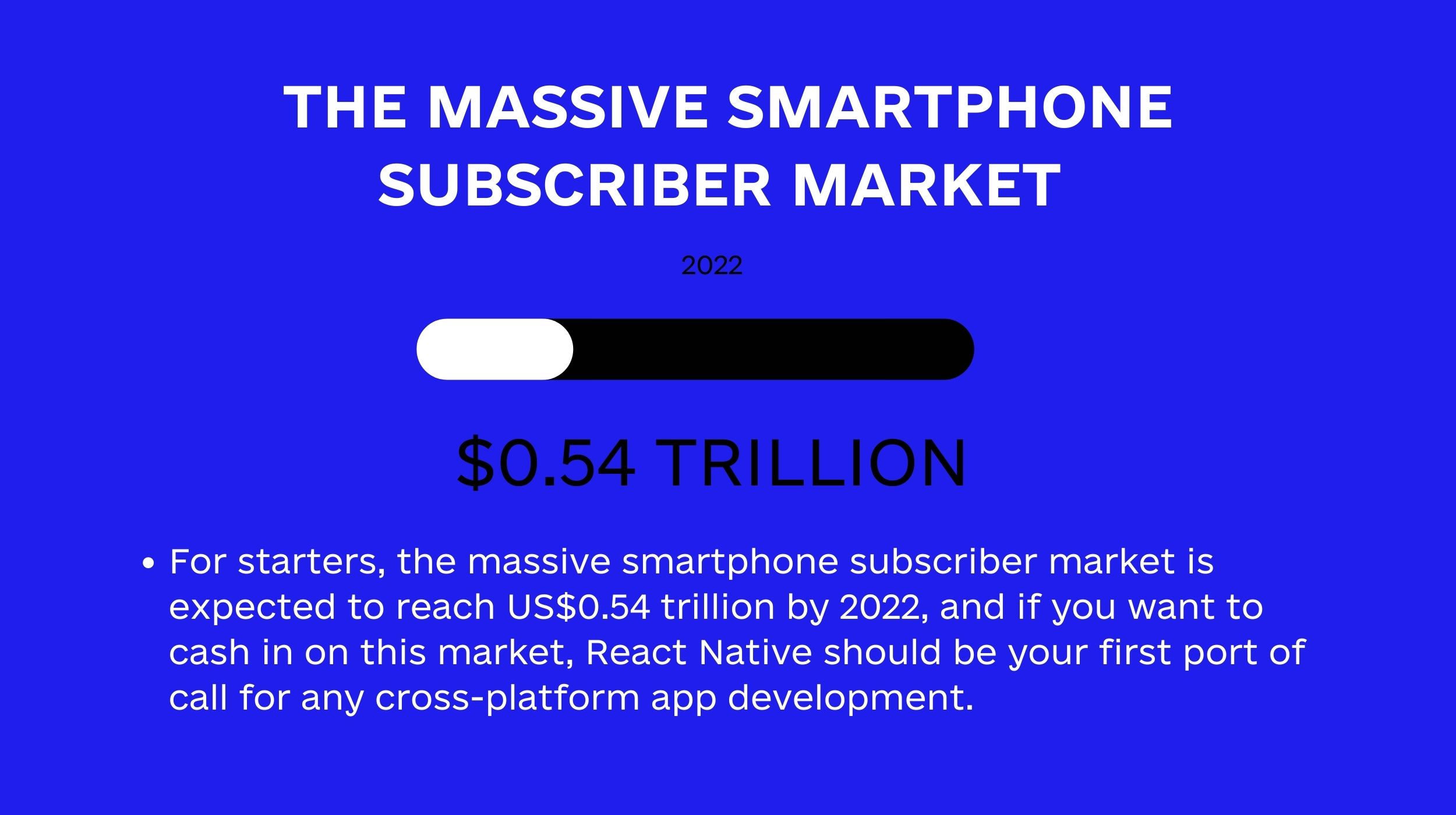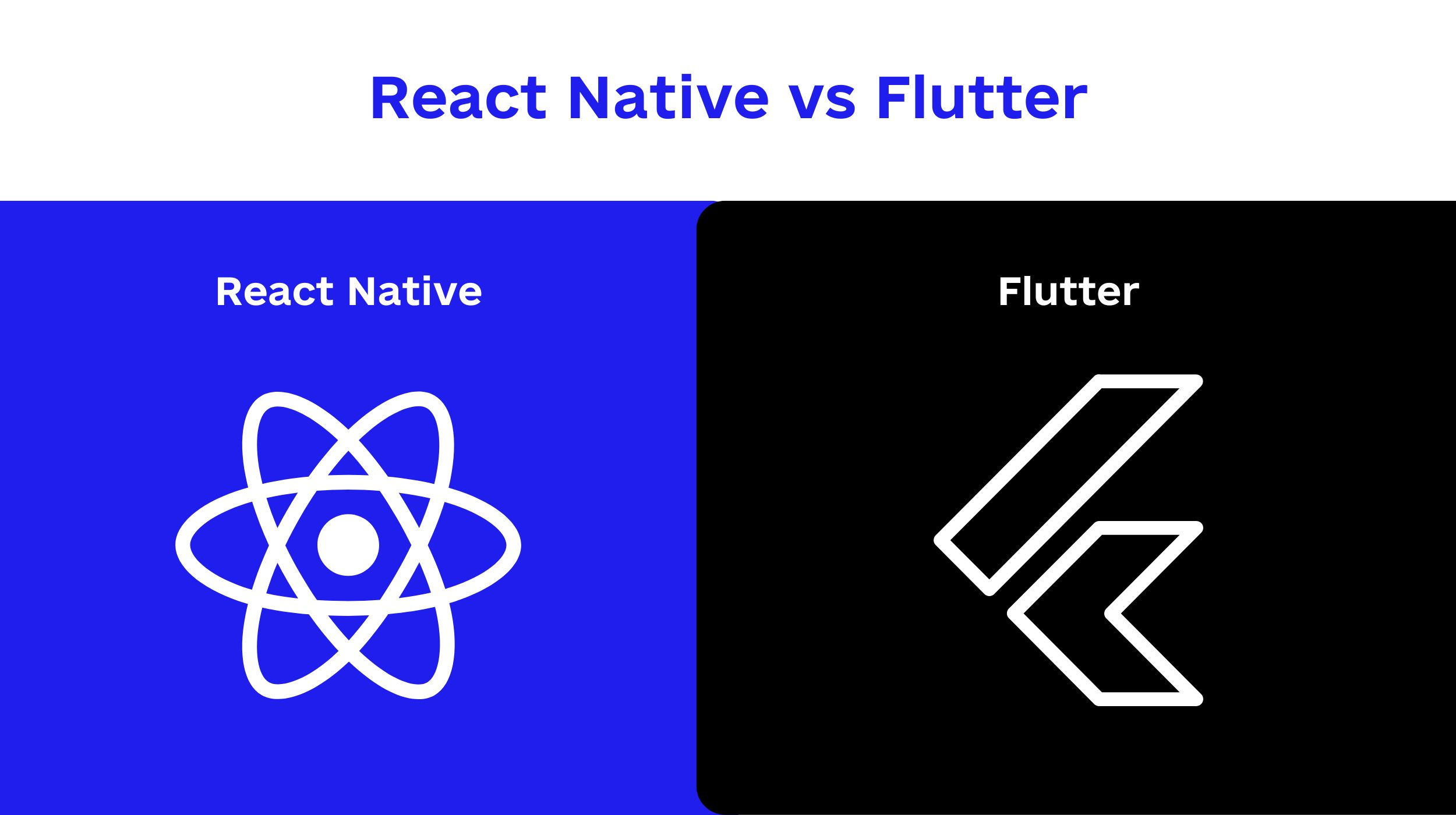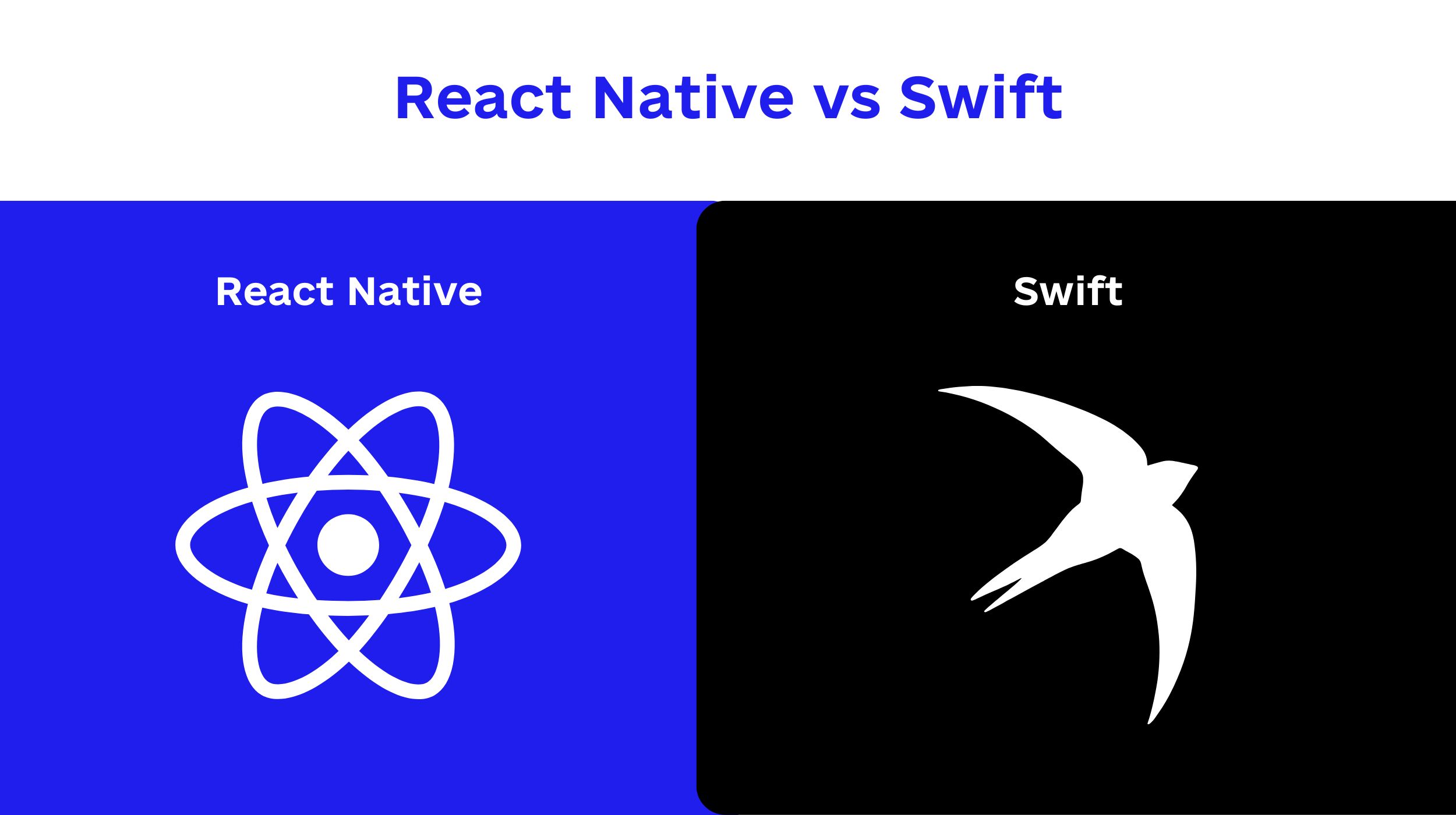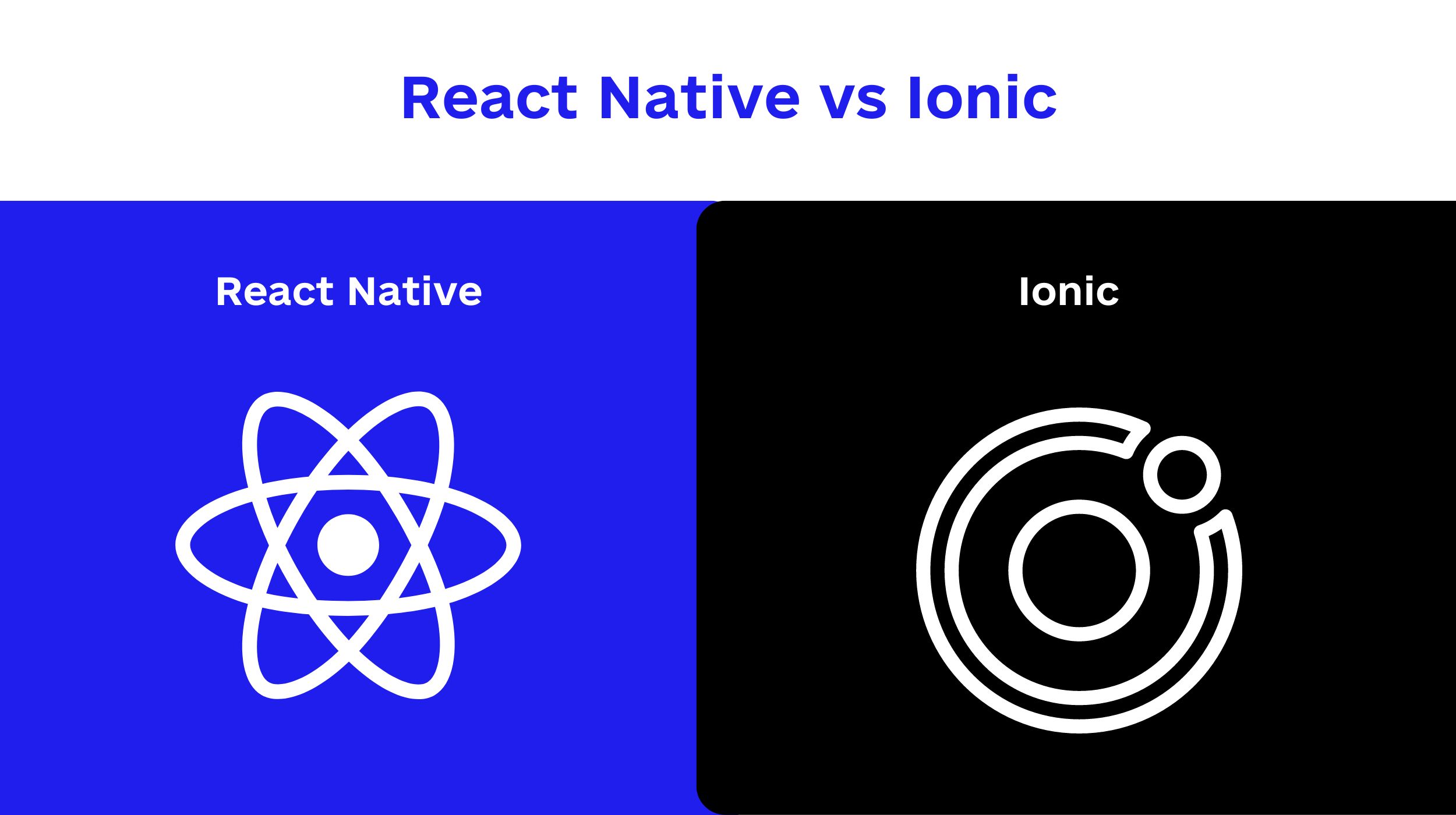Let’s get down to brass tacks and determine if React Native is good for developing mobile applications. For starters, the massive smartphone subscriber market is expected to reach US$0.54 trillion by 2022, and if you want to cash in on this market, React Native should be your first port of call for any cross-platform app development.

In fact, according to data collected by Stack Overflow, React Native is the sixth most popular mobile framework among programmers. Due to its rich features and the ability to run natively on Android and iOS, as well as on a web browser, React Native is preferred for building complex hybrid apps that deliver a natural user experience. These are just a few of React Native’s robust sides. We’ll compare it to three other popular frameworks—flutter, swift, and ionic—to get a feel for its strengths and weaknesses. First, let’s find out why you should use reactive native.
P.S. If you have an app concept in mind but lack a team of React Native engineers, the Code&Care Team is here to help. Contact us here.
Table of Contents
What is React Native and why use it?
React Native is an open-source JavaScript framework that allows developers to write once and deploy the various platforms including iOS, Android, and the web. Similar to React, but with a focus on mobile devices rather than the browser, React Native is a framework for building web apps.
For its user interface, React Native relies on the same standard components seen in native iOS and Android programs. Just use JavaScript and React to assemble those components. If you wish to add native functionality that does not already exist, you will need to write some platform-specific code, which is the one real drawback to its native components.

The following are some of React Native’s primary capabilities:
- React: To create online and mobile applications with JavaScript, developers may use a framework like React.
- Native: You can use JavaScript to manage native components.
- Platform: React Native runs on both the iOS or Android operating systems.
Now that we’ve covered the basics, let’s go over more advanced reasons why you should use React Native.
So, why is React Native good for mobile app development?
Here are some of the main benefits of using react native when creating apps for mobile apps.
- Source Code Available to the Public
The open source framework is a group of software developers’ pre-made tools for making websites, UIs, and simple programs.
Since it is an open-source framework, React Native may be used by anybody at no cost to create apps.
- Support from Facebook
It was discovered in 2015 that Facebook financially supports React Native. With Facebook’s backing, the stability of React Native has risen significantly. One of the best things about React Native is that it can do this.
Since a major player in the IT industry like Facebook is using it, React Native has attracted the attention of many businesses.
Because of Facebook’s backing, React Native is now a viable option on a worldwide scale.
- Structured in modules, and easily understood
With React, it’s simple for other programmers to get into an existing project and build upon its success. This improves a team’s adaptability and streamlines the process of updating and improving web apps.
It may take less time for testers to understand the code logic and create useful testing scenarios. Any client and/or chief financial officer may welcome the news of significant time savings that this may bring about.
The main reason a company like Facebook would choose React Native is to speed up the development process. That’s right; it’s all because of how quickly you can create apps using React Native.
The time it takes to create a mobile app using React Native is drastically reduced as compared to using a more traditional framework.
For this reason, a React Native app has far more interaction with its users. The proportion of users that delete a React app is likewise incredibly low, as has been repeatedly shown.
Google gives higher rankings to sites built using React Native because of the increased speed with which the search engine crawls pages built with this framework.
- To maximize code reusability and minimize expenses
Using React Native, you may reuse existing code easier. Developers are spared the trouble of duplicating their efforts to implement the same logic in several places. This ensures uniformity across devices for the mobile app’s clientele. About 90-95% of the code may be reused across iOS and Android.
- Actual, real-time reload
When you make a modification to an HTML page, CSS, JavaScript, or Web Connection script while the React Native framework is loaded, the page will automatically refresh. If feasible, the current page’s location will be preserved.
- Outstanding functionality in mobile settings
With React Native’s cross-platform capabilities, you just need to create a single codebase to support both Android and iOS. Developing a native app usually involves the efforts of two software engineers, one each for iOS and Android, due to the necessity for specialized code for each platform.
The popularity of React Native: Why do programmers prefer Reactive Native?
There are three main reasons for RN’s success: high-profile endorsements and a robust user base, portability across several platforms, and intuitive design.
React Native is one of the most stable and trustworthy cross-platform development frameworks, and as such is used by many well-known firms when creating mobile applications.
React Native’s flexibility lies in its ability to be used to create mobile apps that run on several platforms. It provides the most effective optimization for mobile apps and makes it possible for React Native developers to use Native code.
If you want to create an app, for example, and you know Java, you may be able to do it for the Android platform but not for iOS. It will take a lot of work for Android developers to create an app for iOS. With RN, though, you have the advantages of both Android and iOS. And there’s no need to fret about support as the source code for reactive programming is freely available.
RN’s framework is easy to use. All you need is a firm grasp of js and E SCRIPT to get going with RN.
React Native vs Flutter

Both React Native and Flutter are popular options for building mobile applications. There are, however, nitpicky differences between RN and flutter that define why some programmers favor one over the other. According to the research, by 2020, 42% of developers would have selected React Native over Flutter.
The primary distinction between Flutter and React Native is that the former employs a widget-based approach to UI construction, while the latter relies on JavaScript and JSX. Because of the availability of pre-built widgets in Flutter, developers are not required to design their own unless they so want. You may be certain that the widgets will work together without a hitch since Google developed and tested them.
How do they stack up?
- Development
Flutter is quick in comparison to other cross-platform app development frameworks, however it is slower than React Native. The issue is that separate code files must be included when working with Flutter for Android and iOS. This, however, only occurs when the software in question calls for more intricate UI features. However, Flutter has multiple third-party UI frameworks available, each with its own set of prebuilt components. The development time is cut down as a result. Actually, these libraries do make development easier.
- Hot reloading
Hot reloading/restarting is supported by both React Native and Flutter. These capabilities allow the developer to see the effects of their work immediately.
- Performance
Dart, the language in which Flutter was created, provides for faster code compilation than JavaScript. And because of this, Flutter is capable of displaying animations at a typical 60 frames per second. All Flutter applications, by default, have excellent performance. Nonetheless, it’s important to remember that the pace might be impacted by a few standard issues. If you’re having trouble getting the results you want, Flutter can give you some suggestions on how to improve your situation. A few examples of suggestions are:
- Tree-shaking and delayed loading for peak efficiency.
- Placeholder images, preloading, and turning off transitions in the navigation system all contribute to a noticeable speed boost.
- Writing efficient Flutter components
Flutter also suggests utilizing lazy methods for grids and lists, limiting the use of effects and widgets to when they are really needed, and keeping frame rates to a minimum of 16 milliseconds. When comparing Flutter’s performance to that of React Native, we must acknowledge that Flutter is not in the lead. Many developers, however, agree that Flutter’s many additional benefits make it the superior option.
- Documentation
An open-source software development kit, Flutter’s documentation makes it simple to create apps that run on several platforms. Creating high-quality, natively built applications for iOS and Android is now a breeze. A single set of codes may serve both systems.
All questions may be answered by reading Flutter’s well-organized documentation. Many developers still choose Flutter above other options because of the many online resources available to them. The only real negative of Flutter is its documentation, which requires frequent internet visits. However, the website’s well-organized contents make any drawbacks practically imperceptible. The docs.flutter.io website provides the official open-source documentation for Flutter.
How React Native beats flutter!
The advantages of React Native vs Flutter
When developing for many platforms using Flutter, the resulting app is called a “Flutter app,” rather than a “native app” for any one of those platforms. The user interface and functionality of each Flutter app are unique. However, React Native provides a cross-platform developer interface for accessing and using local UI components native to individual platforms (React).
Rather than relying on the platform-specific GUI toolkit constraints, we typically employ cross-platform frameworks due to the time-consuming nature of developing native applications. However, unlike native app frameworks like React Native, Flutter only produces Flutter applications.
Modern developers, who often come from a web programming background, might be thrown off by Flutter’s innovative widget tree-based structure.
Because of Hermes and the fact that it uses the same JavaScript implementation as the browser API, React Native’s development environment is more productive for programmers than Flutter.
React Native vs Swift

Apple’s latest programming language, Swift, is a general purpose, a multi-paradigm language developed specifically for use in developing iOS and its ecosystem. The current distribution of the language is under the Apache License, making it free for anybody to use. It’s a new initiative that only got started in June 2014, seven years after the introduction of the first iPhone.
Cross-platform development is where React Native really shines, while iOS app development is where Swift stands out. Thus, you may opt to use Java or Kotlin, for instance, while developing for Android, while sticking with Swift and Objective-C when targeting iOS.
How do they stack up?
- Development speed
In this case, building native iOS apps using Swift will be more efficient than using React Native. The simplest approach to make an iOS app will be using Swift, whereas React Native is a JavaScript framework that is an effective and easy-to-use tool for making web apps.
- Programming language
React Native is a framework for developing mobile and desktop apps that may make use of the JavaScript programming language. Nowadays, JavaScript is one of the most widely used languages on the web. This language is often used with the React framework, in addition to other well-known JavaScript libraries.
Objective-C was Apple’s original programming language, and Swift was created to replace it.
- User interface
The interface of the application is designed to mimic that of the operating system. Since React Native relies on native components, developers can rest certain that their apps’ features will remain up-to-date even after major OS UI revisions.
Swift, Apple’s native iOS language for app development, does a fabulous job at both integrating into iOS design and using UX concepts. But writing an app in Swift is like starting from scratch when it comes to creating a native app. Thus, each component must be hand-crafted and refined to perfection.
- Performance
An independent Swift app will often outperform a framework. Swift offers superior speed than React Native, despite the fact that it might need more CPU resources to execute an application.
However, the React Native framework has several issues when working with visual effects. ReactNative gives programmers the freedom to integrate their own code into the app, or to use a variety of resources and tools to find solutions to issues.
React Native vs Ionic

When comparing Ionic to React Native, it’s important to keep in mind that Ionic is an open-source, free front-end SDK framework that lets you build native mobile apps for iOS, Windows, and Android from a single set of source files. It ends up being a useful tool for developing mobile apps that work on several platforms. It’s a handy program for making hybrid cell phone apps.
The primary distinction between Ionic and React Native is that Ionic is web-first, while React Native relies on platform-specific UI controls. Instead, Ionic uses cross-platform, standards-based web technologies to build native iOS and Android UI patterns. On the other hand, React Native offers an abstraction through React for managing UI controls on the platform natively.
How do they stack up?
- Architecture
To put it simply, Ionic is a wrapper that uses a WebView (a full-screen native component of a web browser) to display HTML, CSS, and Javascript code for use in creating mobile applications. Running time technologies like Cordova and Capacitor link the WebView to the Ionic framework. An Ionic app is just a mobile website that has been converted into an app.
Also, unlike React Native, Ionic doesn’t need its own underlying framework to function. Due to its nature as a mobile wrapper for a website, any web framework (including React, Vue, Angular, or even vanilla JavaScript) may be used as the underlying technology. Only the React Native framework, an expansion of the React framework for web development, may be used to create React Native.
- Ionic vs. React Native difficulty level
To estimate how soon a developer unfamiliar with the framework can build your chat app, you must have a firm grasp of the framework’s degree of complexity.
- Programming languages
Since React itself is built on Javascript, it follows that React Native will use the same language. While Ionic is framework-agnostic, it does restrict developers to using just HTML, CSS, and Javascript.
Most web developers already have a working knowledge of Javascript, making it easy to learn and implement any framework.
- Framework complexity
Since an Ionic app may be written using any number of web frameworks, it’s difficult to evaluate the relative complexity of Ionic and React Native.
Learning Ionic will be less of a challenge if you already have experience with web programming since it makes use of many of the same technologies. However, if you already know JavaScript and are acquainted with the web-based React framework, picking up React Native shouldn’t be too much of a challenge.
Final thoughts
After only a few years since its first release, React Native has quickly established itself as a front-runner in the mobile app development business, as it should. RN is an effective framework for software developers, a lucrative technology for commercial enterprises, and a solution that meets the needs of end users. Therefore, if you are thinking of developing a mobile app that is compatible with multiple platforms, then you should consider using React Native.
Ready to create a cross-platform app for a wide variety of users? Call us to get the ball rolling on your next project by calling.
Read also:
Your Go-to Guide to Live Streaming Shopping App Development in 2022
How to Build a School Management System: Steps, Features, Benefits, and Costs
How to Build a Job Search Website: Extended Guide [5 Key Steps]
















Popular
Latest